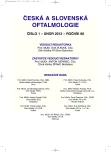Incidence of Retractive Errors with Corrective Aids Subsequent Selection
Authors:
Beneš P.1 ,4; S. Synek 2; S. Petrová 2; J. Sokolová Šidlová 1; L. Forýtková 3; Z. Holoubková 4
Authors‘ workplace:
Klinika nemocí očních a optometrie LF MU, Fakultní nemocnice u svaté Anny, Brno, přednosta doc. MUDr. Svatopluk Synek, CSc.
; Katedra optometrie a ortoptiky – Pracoviště nelékařských oborů, Lékařská fakulta
1; Klinika nemocí očních a optometrie – Společná pracoviště s Fakultní nemocnicí U Svaté Anny – Lékařská fakulta
2; Biofyzikální ústav – Teoretická pracoviště – Lékařská fakulta
3; Oční optika – Rubín, Brno
4
Published in:
Čes. a slov. Oftal., 68, 2012, No. 1, p. 11-16
Category:
Original Article
Overview
This study follows the occurrence of refractive errors in population and the possible selection of the appropriate type of corrective aids. Objective measurement and subsequent determination of the subjective refraction of the eye is an essential act in opotmetric practice. The file represented by 615 patients (1230 eyes) is divided according to the refractive error of myopia, hyperopia and as a control group are listed emetropic clients. The results of objective and subjective values of refraction are compared and statistically processed.
Methods:
The study included 615 respondents. To determine the objective refraction the autorefraktokeratometer with Placido disc was used and the values of spherical and astigmatic correction components, including the axis were recorded. These measurements were subsequently verified and tested subjectively using the trial lenses and the projection optotype to the normal investigative distance of 5 meters. After this the appropriate corrective aids were then recommended.
Results:
Group I consists of 123 men and 195 women with myopia (n = 635) of clients with an average age 39 ± 18,9 years. Objective refraction – sphere: -2,57 ± 2,46 D, cylinder: -1,1 ± 1,01 D, axis of: 100° ± 53,16°. Subjective results are as follows - the value of sphere: -2,28 ± 2,33 D, cylinder -0,63 ± 0,80 D, axis of: 99,8° ± 56,64°.
Group II is represented hyperopic clients and consists of 67 men and 107 women (n = 348). The average age is 58,84 ± 16,73 years. Objective refraction has values - sphere: +2,81 ± 2,21 D, cylinder: -1,0 ± 0,94 D; axis 95° ± 45,4°. Subsequent determination of subjective refraction has the following results - sphere: +2,28 ± 2,06 D; cylinder: -0,49 ± 0,85 D, axis of: 95,9° ± 46,4°.
Group III consists from emetropes whose final minimum viasual acuity was Vmin = 1,0 (5/5) or better. Overall, this control group is represented 52 males and 71 females (n = 247). The average age was 43 ± 18,73 years. Objective refraction - sphere: +0,32 ± 0,45 D; cylinder: -0,51 ± 0,28 D, axis of: 94,7° ± 57,5°.
Discussion:
Values of objective refraction take higher values than the subsequent execution of the subjective examination of the refractive error and recommendation of the appropriate type of corrective aids. This all is in examined groups and in the individual components of refractive errors. It also confirmed the hypothesis that the population outweighs with-the-rule astigmatism, the deployment of resources according to the literature ranges from 90° ± 10°.
Conclussion:
The values observed correction of refractive errors are then derived also offer the most common prescription ranges and products for the correction of given ametropia. In the selection and design corrective aids, we are often limited. Our task is then to manufacture high quality, functional and aesthetic corrective aids, you need to connect knowledge from the fields of optics, optometry and ophthalmology. Faster visual rehabilitation simplifies clients’ rapid return to everyday life.
Key words:
refractive error, objective refraction, subjective refraction, glasses, contact lenses, population
Sources
1. Beneš, P., Petrová, S. a Holoubková, Z.: Optická praktika. Elportál [online]. 1. vyd. Brno: Masarykova univerzita, vyd. 4. 10. 2010 [cit. 2010-10-04]. Dostupné z WWW: <http://is.muni.cz/elportal/?id=901008>. ISSN 1802-128X.
2. Beneš, P.: Lepší vízus díky asférické ploše. Česká oční optika. Praha: EXPO DATA, spol. s.r.o, 2011, 52(2), s.74–76, 3 s. ISSN 1211-233X.
3. Efron, N.: Contact lens practice. 2nd edition. China: Butterworth Heinemann Elsevier, 2010. ISBN 978-0-7506-8869-7.
4. Chen, M. J., Liu,Y. T., Tsai, C. C., Chen, Y. C., Chou, C. K., Lee, S. M.: Relationship between central corneal thickness, refractive error, corneal curvature, anterior chamber depth and axial lenght. Journal of the Chinese Medical Association, 2009, 72(3), pp. 133-137. ISSN 1726-4901.
5. Kamiya, K., Shimizu, K. and Ohmoto, F.: Effect of aging on corneal biomechanical parameters using the ocular response analyzer. Journal of Refractive Surgery, 2009, 25(10), pp. 888-893. ISSN 1081-597X.
6. Kolín, J. a kol.: Oftalmologie praktického lékaře. 1. vydání. Praha: Univerzita Karlova, 1994. ISBN 80-7066-861-X.
7. Remon,L., Benlloch, J., Furlan, W.D.: Corneal and Refractive Astigmatism in Adults: A Power Vector Analysis. Optometry and Vision Science. 2009, 86(10), pp. 1182-1186. ISSN 1040-5488.
8. Touzeau, O, Borderie, V., Loison, K., Allouch, C., Scheer, S., Chastang, P, Laroche, L.: Corelation between corneal topography and subjective refraction in idiopathic and surgery-inducted astigmatism. Journal Francais d’Ophtalmologie, 2001, 24(2). ISSN 0181-5512.
Labels
OphthalmologyArticle was published in
Czech and Slovak Ophthalmology

2012 Issue 1
Most read in this issue
- Gases in Vitreoretinal Surgery
- Floppy Eyelid Syndrome and Obstructive Sleep Apnoea
- Selected Prognostic Factors of Malignant Uveal Melanoma
- Comparative Study of Intraocular Pressure Measurements by Goldmann Applanation Tonometer, Noncontact Tonometer and TonoPen
